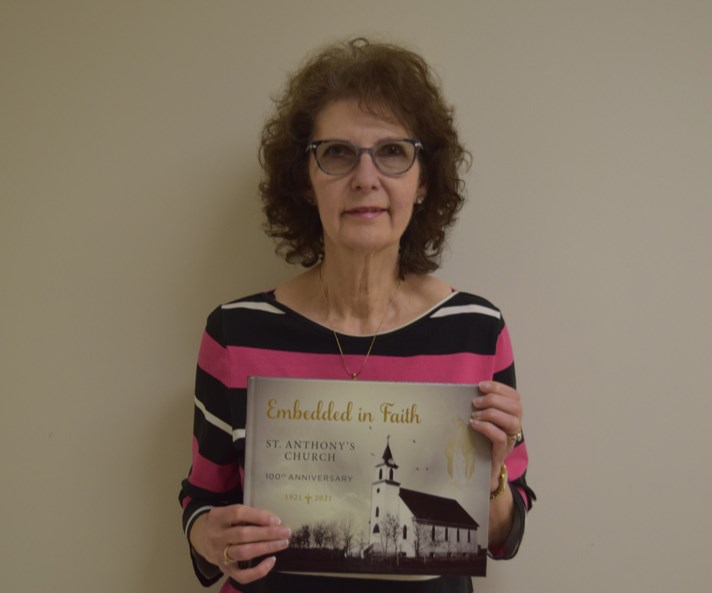RAMA - It had to wait until 2022, but St. Anthony’s Church in Rama celebrated its 100th anniversary. The church held its first mass in 1921, however COVID-19 restrictions cause the celebration to be delayed.
In planning for the centennial celebrations, Mary Kowalyshyn said the idea came up to publish a history book for the occasion.
“All agreed that this history should never be lost and this would be the best time to preserve the history of St. Anthony’s Church,” said Kowalyshyn, who compiled and edited the book, Embedded in Faith which is about 200 pages long “and is quite detailed with a lot of history and pictures.”
“It was indeed a pleasure to learn so much history about our faithful ancestors who were so ‘embedded in their faith.’ Thus, the title of the book emerged.”
Kowalyshyn relied on multiple sources for the information and photos in the book.
“The primary source was from the journal of Rev. Father Anthony Sylla O.M.I. who was parish priest for 29 years. He spearheaded the building of the parish hall, church rectory and of course our grotto, 'The Shrine of Our Lady of Lourdes,' situated west of the church. I received historical information from the Archdiocesan Archives in Regina and families of former and present parishioners who also submitted photos. As for the more recent photos, they were mostly from my albums.”
The book is structured in chronological order, from the first country church in the 1920’s in Dobrowody named St. Peter & St. Paul, and then ending in 2021.
“Church groups and memorable events follow,” said Kowalyshyn. “Our Lady of Lourdes Shrine takes a good portion of the book. The history of the families goes in alphabetical order and ends with a Final Note to our descendants who were very much ‘embedded in their faith.’”
The book project took almost two years for Kowalyshyn to complete, mostly during the pandemic.
“What surprised me most was the challenges along with all the difficulties these people faced in order to build a strong foundation of faith for future generations. I enjoyed seeing all the old photos that were submitted. Many were so unbelievable with horses, bicycles and huge crowds of people at important Feast days.”
The book begins with the section appropriately titled “In the Beginning…” which includes details of the first organizational committee meeting for the church in August 1920,
“It was decided to buy three lots from the village of Rama and start building the church without delay. On August 7, at the second meeting, it was recommended that Mr. Frank Nowakowski, an experienced carpenter from Poland, who had moved from the district of Dobrowody to Rama, be entrusted with the plans and building of the new church. Every farmer was willing to pledge $25 for the new church. Parishioners were anxious to start, some pledging $100 toward the building of the new church.”
The official opening took place with the first High Mass on July 3, 1921. In attendance were 45 families with a total of 250 people.
“Parishioners of Rama were filled with great joy and thanked God, the Almighty that they now had a beautiful, large church in which they were able to worship and have divine services.”
When Father Anthony Sylla first came to Rama in 1933, he had already envisioned the building of a grotto as a devotion to the Blessed Virgin Mary, making it the centre of religious life in Saskatchewan.
“It wasn’t until Sept. 1, 1939, the eve of the Second World War, when Poland had been invaded that this idea would come to fruition. That very evening, Fr. Sylla summoned his parishioners, asking them to haul fieldstones to have the grotto built so that there would be a place to pray for peace in the world. Thus began the construction with parishioners of Rama and Dobrowody hauling their fieldstones with horses and stone boats.”
Of course, over the course of 100 years, things happened that were beyond human control and challenges had to be overcome.
“The 1980s began with a blast when the house across the street owned by Edward and Helen Yaworski exploded on March 6. The church experienced a lot of damage! A two-by-four penetrated right through the east wall of the church. The stained glass windows shattered and many were broken. Insulation was scattered about the churchyard. Some pictures of the Stations of the Cross were on the floor with segments broken off, but amazingly, the face and body of Jesus on the crucifix which hung on the wall were completely intact. The basement too had shifted, making the floor unsafe with the concrete broken up. The parishioners needed much time to clean up the mess.”
Kowalyshyn said her goal is that the book leaves a lasting message with readers.
“I'm sincerely hoping that the younger generation can see and come to understand what our pioneers had to go through in order to make life 'good' for our generation. I hope that they can understand the value and importance of deep faith just as the pioneers had and to continue to carry on their faith, just as our pioneers did.”
Even though Kowalyshyn had plenty of time to work on the book during the pandemic restrictions, there was a significant downside.
“It was very difficult to meet with our history group during COVID, but some helped in any way that they could, providing photos and family histories. My husband, Joe, often proofread and helped out whenever he could.”
Anyone interested in purchasing the book, or just looking for more information, is encouraged to contact Mary Kowalyshyn. It will also be available for purchase at the annual pilgrimage at the Shrine of the Lady of Lourdes on Aug. 14-15.
“Even though it took many hours to compile, with all the positive comments that have been received, it was so worth it!” concluded Kowalyshyn. “Everyone should know their roots.”




